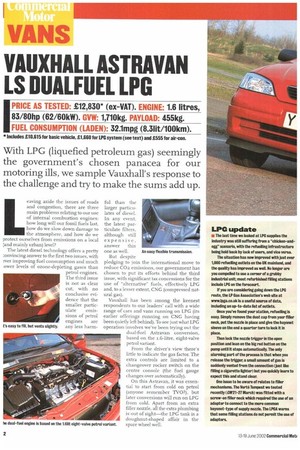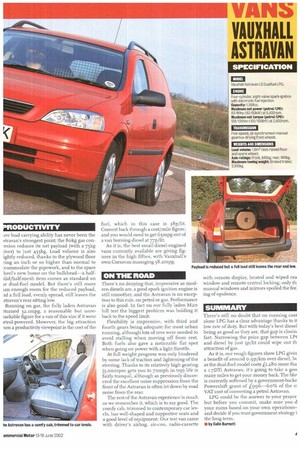VAUXHALL ASTRAVAN LS DUALFUEL LPG
Page 42

Page 43

If you've noticed an error in this article please click here to report it so we can fix it.
!PRICE AS TESTED: E12,830* (ex-VAT). ENGINE: 1.6 Wes, 83/80hp (62/60kW). OW: mokg. PAYLOAD: 455kg. FUEL CONSUMPTION (LADEN): 32.1mpg (8.31it/100km). * Includes £10,615 for basic vehicle, £1,660 for LPG system (see text) and £555 for air-con.
With LPG (liquefied petroleum gas) seemingly the government's chosen panacea for our motoring ills, we sample Vauxhall's response to the challenge and try to make the sums add up.
Lcaving aside the issues of roads and congestion, there are three main problems relating to our use of internal combustion engines: how long will our fossil fuels last, how do we slow down damage to the atmosphere, and how do we protect ourselves from emissions on a local and mainly urban) level?
The latest diesel technology offers a pretty :onvincing answer to the first two issues, with ever improving fuel consumption and much ower levels of ozone-depleting gases than petrol engines. The third issue is not as clear cut, with no conclusive evidence that the smaller partic
ulate emissions of petrol engines are any less harm ful than the larger particulates of diesel. In any event, the latest particulate filters, although still expensive, answer this one as well.
But despite pledging to join the international move to reduce CO2 emissions, our government has chosen to put its efforts behind the third issue, with significant tax concessions for the use of "alternative" fuels, effectively LPG and, to a lesser extent, CNG (compressed natural gas).
Vauxhall has been among the keenest respondents to our leaders' call with a wide range of cars and vans running on LPG (its earlier offerings running on CNG having been quietly left behind). To see just what LPG operation involves we've been trying out the dual-fuel Astravan conversion, based on the r.6-litre, eight-valve petrol variant.
From the driver's view there's little to indicate the gas factor. The extra controls are limited to a changeover rocker switch on the centre console (the fuel gauge changes over automatically).
On this Astravan, it was essential to start from cold on petrol (anyone remember TVO ?), but later conversions will run on LPG from cold. Apart from an extra filler nozzle, all the extra plumbing is out of sight—the LPG tank is a doughnut-shaped affair in the spare wheel well. ODUCTIVITY
are load carrying ability has never been the stravan's strongest point; the 8okg gas contsion reduces its net payload (with a 75kg river) to just 455kg. Load volume is also ightly reduced, thanks to the plywood floor ring an inch or so higher than normal to :commodate the pipework, and to the spare heel's new home on the bulkhead—a half)1id/half-mesh item comes as standard on ie dual-fuel model. But there's still more ian enough room for the reduced payload, ad a full load, evenly spread, still leaves the stravan's rear sitting low.
Running on gas, the fully laden Astravan turned 32.impg, a reasonable but unreiarkable figure for a van of this size if it were etrol-powered. However, the big attraction 'cm a productivity viewpoint is the cost of the
fuel, which in this case is 38p/lit. Convert back through a cost/mile figure, and you would need to get 65mpg out of a van burning diesel at 77p/lit.
As it is, the best small diesel-engined vans currently available are giving figures in the high fifties, with Vauxhall's own Corsavan managing 58.2mpg.
ON THE ROAD There's no denying that, impressive as modem diesels are, a good spark ignition engine is still smoother, and the Astravan is no exception to this rule, on petrol or gas. Performance is also good. In fact on our fully laden M20 hill test the biggest problem was holding it back to the speed limit.
Flexibility is impressive, with third and fourth gears being adequate for most urban running, although lots of revs were needed to avoid stalling when moving off from rest. Both fuels also gave a noticeable flat spot when going on power with a light throttle.
At full weight progress was only hindered by some lack of traction and lightening of the steering. Thanks to its relatively high gearing (3,000rpm gets you to 7omph in top) life is fairly tranquil, although as previously discovered the excellent noise suppression from the front of the Astravan is often let down by road noise from the rear.
The rest of the Astravan experience is much as we remember it, which is to say good. The comfy cab, trimmed to contemporary car levels, has well-shaped and supportive seats and a good level of equipment. Our test van came with driver's airbag, air-con, radio-cassette
with remote display, heated and wiped rea window and remote central locking; only th manual windows and mirrors spoiled the fee. ing of opulence.
SUMMARY
There's still no doubt that on running cost alone LPG has a clear advantage thanks to it low rate of duty. But with today's best diesel being as good as they are, that gap is dosin fast. Narrowing the price gap between LP( and diesel by just 5p/lit could wipe out th attraction of gas.
As it is, our rough figures show LPG givin a benefit of around o.9p/km over diesel, bt as the dual-fuel model costs £1,280 more tha a r.7DTi Astravan, it's going to take a goo many miles to get your money back. The bl(y is currently softened by a government-backe Powershift grant of £996-60% of the e: VAT cost of converting a petrol Astravan.
LPG could be the answer to your prayer but before you commit, make sure you d your sums based on your own operationsand decide if you trust government strategy i the long term.
• by Conn Barnett




















































































































































